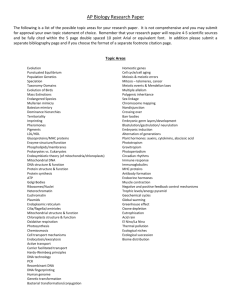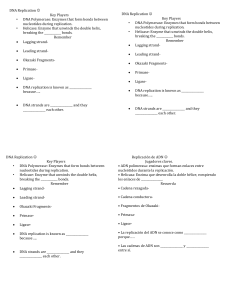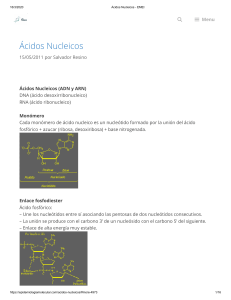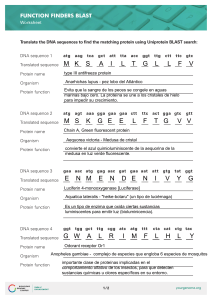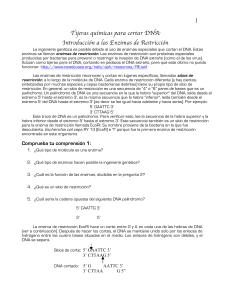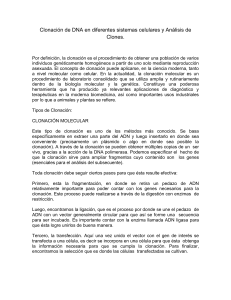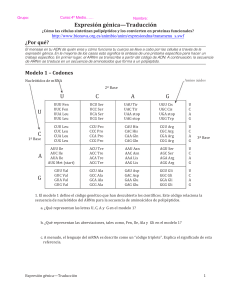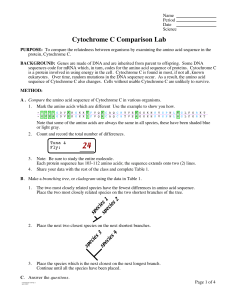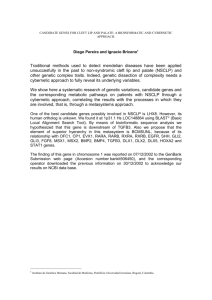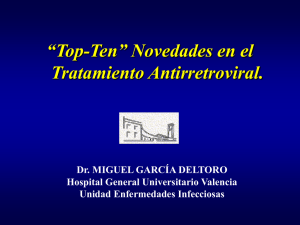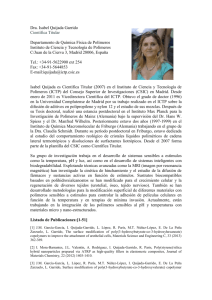Introduction to Organic Chemistry 2 ed William H. Brown
advertisement
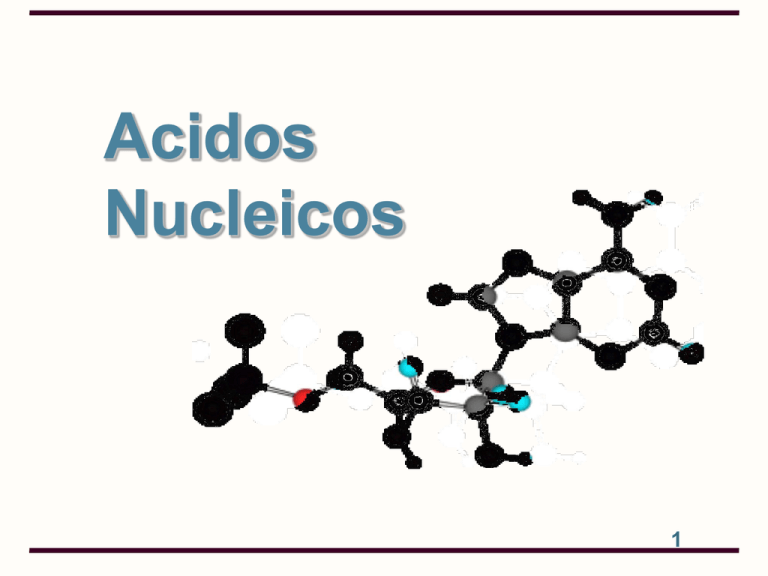
Acidos Nucleicos 1 Ácidos nucléicos • Ácidos nucléicos : un biopolímero que contiene tres tipos de monómeros unidos • Una base orgánica heterociclo nitrogenado aromático derivado de purina y pirimidina • Un azúcar monosacárido D-ribosa o 2-deoxi-D-ribosa • ácido fosfórico • su nombre viene de que son muy abundantes en los núcleos celulares y de su carácter ácido • El más importente es el DNA que es el material genético. • En la siguiente diapositiva se muestra el nombre y abreviaturas de algunas bases nitrogenadas 2 Bases Purina/Pirimidina O O 4 3 N 2 HN 5 6 N O O 1 6 1 2 N N 8 N 3 4 N9 Purina H N1 O O N N N N1 H Citosina (C) NH2 7 5 N H Timina (T) H Uracil (U) Pirimidina CH3 HN N1 NH2 N H Adenina (A) N HN H2 N N N H Guanina (G) 3 Nucleósidos • Nucleósido: son glucósidos cuya base son las nitrogenadas indicadas, contienen D-ribosa o 2deoxy-D-ribose unidas a la bases por un enlace -N-glicosídico 4 Nucleósidos • Uridina uracilo O HN -D-ribosido 1 O 5' HOCH2 4' H N O H H Enlace -N glicosídico 1' H carbono anomérico HO OH Uridina 3' 2' 5 Nucleótidos • Nucleótido: un nucleósido con una molecula de acido fofórico está esterificado con el -OH del monosacarido, más comúnmente el 3’-OH o el 5’-OH 6 Nucleótidos • Adenosina 5’-monofosfato (AMP) NH2 N O - 5' O- P - O- CH2 O - H N O H H N 1' H 3' HO N OH 7 Nucleótidos • Deoxitimidina 3’-monofosfato (3’dTMP) O CH3 HN 5' HOCH2 O O H H H N 1' H 3' O H - O P O - O 8 Aciclovir & AZT O N HN H2 N HOCH2 O HN N N O HOCH2 O H H H Aciclovir (Dibujado para ver su semejanza con la 2-deoxyguanosina H N O H H CH3 H H N3 H Azidotimidina (AZT) 9 DNA - 1° Estructura • Ácidos Deoxirribonucleicos (DNA): un biopolímero (polinucleótido) constituido por los ácidos desoxiadenílico, guanílico, citidílico y timidínico unidos por enlaces de éster fosfórico entre 3’-OH de una 2-deoxi-D-ribosa y el 5’-OH de la siguiente 2-deoxi-D-ribosa. Son cadenas monótonas alternándose D-ribosa con fosfato y diferenciándose sólo en las bases colaterales a esa cadena. • Estructura Primaria :la secuencia de bases en el DNA determina su especificidad funcional y la información genética que almacena. 10 DNA – Estructura 1ia; TG O Extremo 5´fosforilado CH3 HN O - O 5' O- P - O- CH2 - O N O O H 1' H H 2' H O H N HN N H2 N N 5' O= P O CH2 - O H O H H 2' H Extremo 3´libre 3' OH H 1' 11 Estructura - 2° DNA • Estructura secundaria : es el ordenamiento de las cadenas de ácidos nucleicos • Hélice Doble : el DNA forma una doble hélice de dos cadenas complementarias con las vueltas a la derecha. Las bases están situadas hacia el interior de la hélice, en planos perpendiculares al eje, y los grupos de fosfórico están hacia el exterior. • Este modelo de doble hélice fue propuesto por James Watson y Francis Crick en 1953 en base a diagramas de rayos X y a las equivalencias A=T y G=C de las bases. 12 T-A Pareja de Bases • El mejor factor estabilizante es la pareja de bases T-A y entre C-G Timina Adenina 13 T-A Pareja de Bases 14 C-G Pareja de Bases Citosina Guanina 15 C-G Pareja de Bases 16 Formas del DNA • B-DNA • • • • es la forma predominante en solución acuosa diluida hélices con las vueltas a la derecha 34 Å por 10 pares de bases; 20 Å de espesor surco menor de 12 Å y el mayor de 22 Å • A-DNA • una helice diestra, pero de mayor espesor que B-DNA • 29 Å por 10 pares de bases 17 DNA – Estructura 3ia • EstructuraTerciaria : el arreglo de todos los átomos de ácido nucleico en la tercera dimensión, comúnmente referido como superenrollado • Circular DNA: un tipo de ADN double-stranded en el que 5 ' y 3 ' los finales de cada soporte son unidos según enlaces de fosfodiester (Fig 19.10) • Cromatina:consists de herida de moléculas de ADN alrededor de las partículas de histones en una estructura parecida a una cuenta 18 Ácidos Ribonucleicos (RNA) • RNA son similares al DNA en los que tambien son largas cadenas enroyadas de nucleotidos unidos por grupos de fosfodiester siendo el 3’-OH de una pentosa y el 5’-OH de la próxima. However, • the pentose unit in RNA is -D-ribose rather than -2-deoxy-D-ribose • the pyimidine bases in RNA are uracil and cytosine rather than thymine and cytosine • RNA is single stranded rather than double stranded 19 RNA • RNA molecules are classified according to their structure and function Type Molecular Weight Range (g/mol) Numbe r of Nucleotides Percentage of Cell RNA mRNA 25,000 - 1,000,000 75 - 3,000 2 tRNA 23,000 - 30,000 73 - 94 16 rRNA 35,000 - 1,100,000 120 - 2904 82 • Ribosomal RNA (rRNA): a ribonucleic acid found in ribosomes, the site of protein synthesis 20 RNA • Transfer RNA (tRNA): a ribonucleic acid that carries a specific amino acid to the site of protein synthesis on ribosomes O t RNA - O- P - O- CH2 Oamino acid, bound as an ester to its specific tRNA H O H Ba s e H H OH O C O C H R NH3 + 21 RNA • Messenger RNA (mRNA): a ribonucleic acid that carries coded genetic information from DNA to the ribosomes for the synthesis of proteins • present in cells in relatively small amounts and very short-lived • single stranded • its synthesis is directed by information encoded on DNA • a complementary strand of mRNA is synthesized along one strand of an unwound DNA, starting from the 3’ end 22 RNA • Transcription: the synthesis of mRNA from DNA DNA template 3'-A-G-C-C-A-T-G-T-G-A-C-C-5' 5'-U-C-G-G-U-A-C-A-C-U-G-G-3' mRNA 23 El Código Genético • Codon: a triplet of nucleotides on mRNA that directs incorporation of a specific amino acid into a polypeptide sequence 24 5' U C A G U UUU UUC UUA UUG CUU CUC CUA CUG AUU AUC AUA AUG GUU GUC GUA GUG Phe Phe Leu Leu Leu Leu Leu Leu Ile Ile Ile Met Val Val Val Val C UCU UCC UCA UCG CUU CCC CCA CCG ACU ACC ACA ACG GCU GCC GCA GCG Ser Ser Ser Ser Pro Pro Pro Pro Thr Thr Thr Thr Ala Ala Ala Ala A UAU UAC UAA UAG CAU CAC CAA CAG AAU AAC AAA AAG GAU GAC GAA GAG Tyr Tyr Stop Stop His His Gln Gln Asn Asn Lys Lys Asp Asp Glu Glu G UGU UGC UGA UGG CGU CGC CGA CGG AGU AGC AGA AGG GGU GGC GGA GGG Cys Cys Stop Trp Arg Arg Arg Arg Ser Ser Arg Arg Gly Gly Gly Gly 25 3' U C A G U C A G U C A G U C A G The Genetic Code • Properties of the Code • only 61 triplets code for amino acids; the remaining 3 (UAA, UAG, and UGA) signal chain termination • the code is degenerate, which means that several amino acids are coded for by more than one triplet. Leu, Ser, and Arg, for example, are each coded for by six triplets • for the 15 amino acids coded for by 2, 3, or 4 triplets, it is only the third letter of the codon that varies. Gly, for example, is coded for by GGA, GGG, GGC, and GGU • there is no ambiguity in the code; each triplet codes for one and only one amino acid 26 Sequencing DNA • Restriction endonuclease: an enzyme that catalyzes hydrolysis of a particular phosphodiester bond within a DNA strand • over 1000 endonucleases have been isolated and their specificities determined • typically they recognize a set sequence of nucleotides and cleave the DNA at or near that particular sequence • EcoRI from E. coli, for example, cleaves as shown cleavage here EcoRI 5' G-A-A-T-T-C----3' 5' G + 5'- A-A-T-T-C----27 3' Sequencing DNA • examples of endonucleases Enzyme Recognition Sequence Enzyme Recognition Sequence AluI AG CT Hpa II C CGG BalI TGG CCA Mbol GATC FnuDII CG CG N ot I GC GGCCGC HeaIII SacI GAGCT C GG CC 28 Sequencing DNA • Polyacrylamide gel electrophoresis: a technique so sensitive that it is possible to separate nucleic acid fragments differing from one another in only a single nucleotide • Chain termination or dideoxy method: a method developed by Frederick Sanger for sequencing DNA molecules 29 DNA Replication • the sequence of nucleotides on one strand is copied as a complementary strand to form the second strand of double-stranded DNA • this synthesis is catalyzed by the enzyme DNA polymerase • DNA polymerase will carry of this synthesis in vitro using single-stranded DNA as a template, provided the four dNTPs and a primer are present • because the new DNA strand grows from the 5’ to 3’ end, the primer must have a free 3’-OH group to which the first nucleotide of the growing chain is added 30 Chain Termin. Method • The key is addition of a 2’,3’-dideoxynucleoside triphosphate (ddNTP) to the synthesizing medium O O O O- P - O- P - O- P - O- CH2 O- O- O- H H Ba s e O H H H H A 2',3'-dideoxynucleoside triphosphate (ddNTP) • synthesis terminates at any point where a ddNTP becomes incorporated 31 Chain Termin. Method • a single-stranded DNA of unknown sequence is mixed with primer and divided into four separate reaction mixtures • to each mixture is added all four dNTPs, one of which is labeled in its 5’- phosphoryl group with P-32 • also added are DNA polymerase and one of the four ddNTPs • when polyacrylamide gel electrophoresis of each reaction mixture is completed, a piece of x-ray film is placed over the gel to detect gamma radiation from the decay of P-32 • the base sequence of the complement to the original single-stranded template is read directly from the 32 bottom to top of the developed film
